|
The Pavilion of Spain would not
remain in Flushing Meadows Park as the House of Spain in New
York for all Americans. Robert Moses' grand plan for a great
park after the Fair left no room in its acreage for such a structure
no matter how beautiful or well received it was during the Fair.
Rather, the pavilion was destined to make a 900-mile journey
west by truck and by rail to the City of Saint Louis on the banks
of the Mississippi River where it would become The Spanish International
Pavilion - a crown jewel in the city's new and exciting Tourist
Triangle, along with Eero Saarinen's architectural and engineering
marvel, the Gateway Arch, and the city's Busch Memorial Sports
Stadium which would be completed in 1966.
The government of Spain
gifted the Pavilion to the city at the request of Saint Louis'
dynamic mayor Alfonso J. Cervantes (August 27, 1920 – June
23, 1983). Elected mayor in 1965, Cervantes had visited the Fair
and fell in love with the Spanish Pavilion. Known as the "Salesman
Mayor," he had been successful in getting a $2 million bond
issue passed for completion of the Gateway Arch and grounds which
comprise the Jefferson National Westward Expansion Memorial,
the Museum of Westward Expansion and the Old Courthouse. Cervantes
felt that the Pavilion, with its beautiful architecture, excellent
restaurants and stunning exhibit halls, would be an important
addition to the downtown's blossoming tourism area.
-
St.
Louis Mayor
-
Alfonso
J. Cervantes
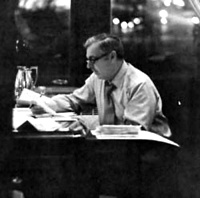 |
A non-profit organization,
The Spanish International Pavilion Foundation, Inc., was organized
to raise the funds necessary to bring the Pavilion to Saint Louis
since no tax funding was requested for the project. For the $5.5
million cost to relocate the Pavilion the city would not only
get the building, it would also be gifted all of the contents
created specifically for the Pavilion (sans the Picassos!)
including magnificent pieces of stained glass, paintings, photographs
and sculpture; all of the contents right down to the tableware
and cutlery created for its restaurants.
-
Top:
Dedication Day of the Spanish International Pavilion in Saint
Louis, May 24, 1969. Middle & Bottom: Thousands of people
turn out for Dedication Day and to tour the Pavilion.
-
-
Source: Archival
Footage, KSDK Channel 5 Television, St. Louis, Missouri - KSDK.com
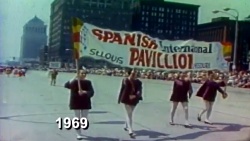 |
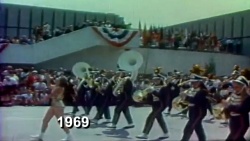 |
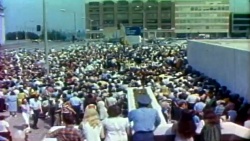 |
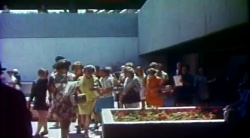 |
 |
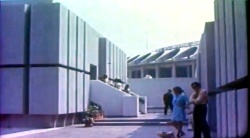 |
On May 24, 1969, a crowd
of some thirty thousand people gathered in downtown Saint Louis
for the dedication of the Spanish International Pavilion. Festivities
included a parade and a gala opening. The summer of 1969 saw
throngs of people visiting the newest attraction to the city's
downtown. But within months the crowds fell off and the Pavilion
and its backers soon found themselves in financial difficulties.
Within a year the Pavilion sat vacant and abandoned at the corner of
Broadway and Market and the Foundation which owned and operated
the Pavilion was bankrupt.
-
Source: Top:
Postcard by St. Louis Color Postcard Co., St. Louis. Bottom:
Postcard by HS Crocker Co., Inc., Oklahoma City
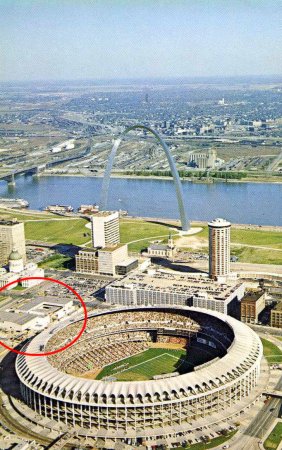 |
- Postcard
Aerial Views of the downtown Saint Louis "Tourist Triangle"
in 1972.
|
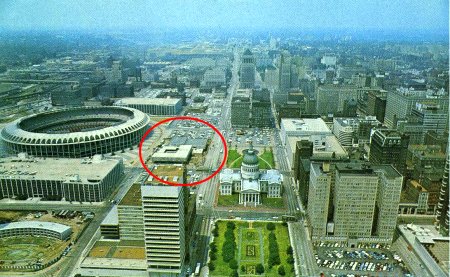 |
- The Spanish
International Pavilion is circled in red on these cards.
|
In 1976, seeing a need
for a hotel near the Busch Stadium ballpark, developer Don Breckenridge
purchased the Pavilion with plans to convert it into a hotel.
A twenty-five story tower was constructed over the central open
courtyard of the Pavilion and it then became known as The
Breckenridge Inn.
-
Architect's
Rendering of the Proposed Breckenridge Inn
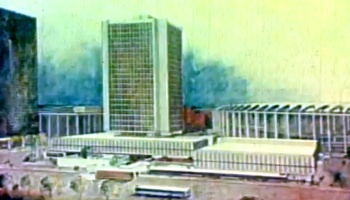 |
In 1979 the Marriott Corporation
purchased The Breckenridge Inn and completed the hotel
conversion. In 1981 Marriott added a second multi-story tower,
this time over the portion of the Pavilion that had once housed
the Theatre. Through both conversions, developers kept the flavor
of the Pavilion's Spanish origins, retaining sculpture and artwork.
Marriott renamed the structure the Marriott Pavilion Saint
Louis and later simply Saint Louis Marriott Downtown.
-
Marriott
Pavilion Saint Louis c. 1989
-
-
Source: KSDK
Channel 5 Television, St. Louis, Missouri - KSDK.com
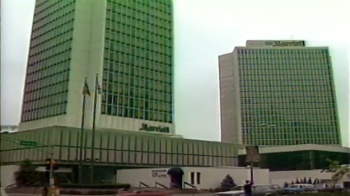 |
In 2005, the hotel changed
hands once again when it was sold to the Hilton chain. Hilton
undertook major renovations at that time and renamed it the Hilton-Saint
Louis at the Ballpark. Although portions of the exterior
still retain the facade of the Spanish Pavilion, it now has the
appearance of an ordinary big-city hotel. Much of the graceful
elegance of the original Spanish Pavilion has been lost in the
several conversions and renovations. It is unknown if the Hilton
renovation retained any of the interior aspects of the pavilion.
A perusal of its website
shows a modern hotel interior with nothing resembling the interiors
of the original Spanish Pavilion.
-
Hilton
St. Louis at the Ballpark Hotel c. 2012
-
-
Source: www.hilton.com
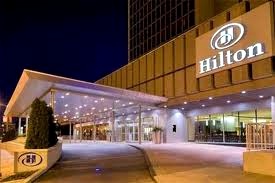 |
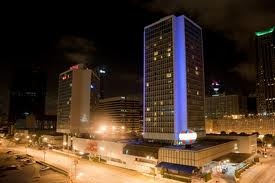 |
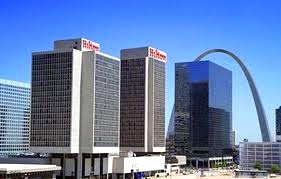 |
- Source: The New York
Times, June 30, 1970
New York World's Fair Hit Turns Into St. Louis Fiasco
The Spanish Pavilion from the New York World's
Fair, transplanted to a site near the Gateway Arch in St. Louis
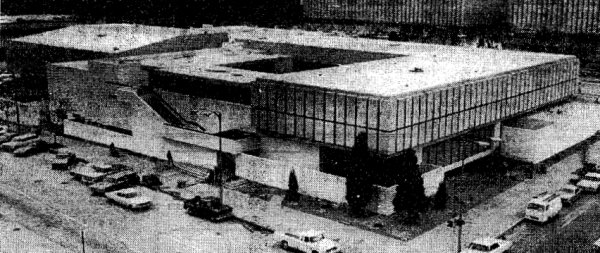 |
|
-
By J. ANTHONY LUKAS
-
Special to the New York Times
-
- ST. LOUIS--After the Cardinals won a recent
game with a timely hit by their Spanish-speaking second baseman,
Julian Javier, several jubilant fans were walking past a vacant
building near the stadium.
-
- "I've got it!" yelped one. "Let's
call it Casa Javier and make it a rest home for retired Caribbean
ball players." The fan's idea scarcely the most far-fetched
proposal for what to do with St. Louis's newest white elephant
-- the Spanish Pavilion, transplanted from New York's 1964-65
World's Fair at a cost of nearly $6-million.
-
- Closed April 20 after less than a year of
debt-ridden operation, the pavilion is now entangled in a legal
jungle of suits and countersuits that may keep it shut for years.
But St. Louisans continue to invent new uses for it.
- Among recent suggestions are a "permanent"
city fair, a convention and visitor's center, a "little
Las Vegas" gambling casino, a motel and a residence for
Mayor Alfonso J. Cervantes. But the housewife who came up with
the last proposal stipulated that the Mayor "should have
to live in it and and pay all the bills out of his own pocket."
-
- From the start the pavilion has been the
Mayor's personal project. When a friend called to tell him the
building (acclaimed by some as "the jewel of the fair")
might be available, he flew to New York and announced "I've
never seen anything like it in my life."
-
- He promptly set out to move and rebuild the
pavilion here. When the fund drive fell far short of its goal,
he decided to go ahead anyway. "At this exciting time in
our history," he said, "it is appropriate to be not
only imaginative but even daring."
-
- The pavilion finally opened in May, 1969,
with 10 days of festivities. The cast of "Man of La Mancha"
sang "The Impossible Dream"; Spain's Minister of Information,
the Mayor of Seville
|
and Jose' Ferrer flew in for the occasion;
several hundred St. Louisans paid $1,000 per couple to dance
at the inaugural "Beile de la Rosas," and as each woman
sat down at the banquet a servant placed a red cushion beneath
her feet. The Mayor, calling it the most enthusiastic, responsive
people's project in the history of any city, dubbed the building
The People's Pavilion.
But the people stayed away. Although a research
concern projected 2,250,000 visitors a year, only 450,000 showed
up between May and December -- most of them out-of-towners.
All three restaurants in the pavilion lost
money, particularly the elegant Toledo, which featured Canbrico
Sea Bass en Papillote (for two), at $14 and Spanish Prawns in
Champagne Sauce, $7.
Manuel Ortuno, who presided over both the
Pavilion's extravagant success in New York and its disaster here,
shook his head recently and said: "People here just don't
go out at night. They go to work, then they go home, drink beer
and watch baseball."
But Marvin Klaman, lawyer for the savings
and loan association that now controls the empty building, says
the old management ran the pavilion as a "country club for
aficionados." He promised that whatever it was destined
to become would have "a real St. Louis flavor."
- Critics of Mayor Cervantes see the pavilion
fiasco as a prime example of the Mayor's flamboyant, improvisational
style. ("I have a tendency to shoot from the hip,"
he told some staff members when he took office. "Sometimes
I hit; sometimes I don't.")
-
- Another mayoral miss was the Santa Maria,
the reproduction of Columbus's flagship, which was also a star
attraction at the World's Fair. She went first to Washington
but was put up for sale last year, and Mayor Cervantes snapped
her up for $375,000 (raised by 10 friends in the business community).
|
In April, 1969, the 90-foot vessel was open
to the public at berth in the Mississippi below Eero Saarinen's
towering Gateway Arch. But two months later, a violent storm
swept her from her mooring and she sank several miles downstream
just off the Illinois shore.
For months, controversy raged about whether
to bother repairing the ship. Many St. Louisans had their doubts,
reinforced when Samuel Eliot Morrison, a leading naval historian,
said the ship was not a reproduction at all but merely "one
version of an educated guess."
But this week the still unfloatable ship will
go back on the riverfront -- this time cradled on a steel framework
between two barges that will also serve as a souvenir shop, snack
bar and restaurant. The St. Louis Post-Dispatch denounced the
project as a "cheap, honky-tonk, carnivalized tourist trap."
There was some skepticism this spring when
the Mayor enthusiastically welcomed a businessman's proposal
for another major project -- a $6-million aquarium on the riverfront.
The next day, State Representative Thomas
A. Walsh, a St. Louis Democrat, introduced a resolution in the
State Legislature hailing the plan with tongue in cheek as comparable
only "to the pyramids of Egypt or the great Sphinx."
The resolution recommended that the aquarium
be named "Alfonso's Watery World of Aquatic Amazements"
and went on to say: "The vision of thousands of rare and
brilliantly marked tropical fish gracefully swimming about in
a $6-million fishbowl, pectoral and dorsal fins glittering in
golden sunlight with possibly a small replica of some ancient
but famous ship floating on placid waters for a final touch of
reality, is a vision that boggles the mind of those unfortunate
ones plagued with a lack of cultural sophistication."
|
|